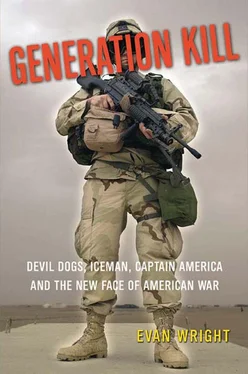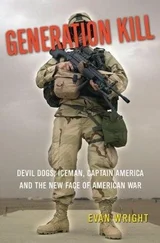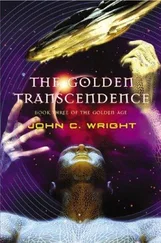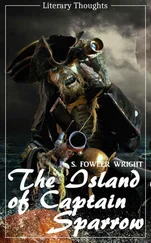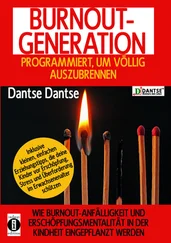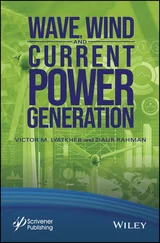Sitting to my left, Trombley says, his voice barely audible, “I hope I get to use her tonight.” He’s referring to his SAW machine gun. Though I can’t see him, I can picture him caressing the top of his SAW as he sometimes does during tender moments before a firefight.
We drive this way for about ten minutes.
Then, after proceeding five kilometers north of the magic line, machine guns, rockets and mortars flash ahead of us in the darkness. The enemy has opened fire on the LAVs in front of us. Now I can see their outlines in the strobe-light effect of bombs and tracers going off around them. The blasts sound like hammers beating on the sides of Colbert’s Humvee.
In the first moments, enemy ambushers who are entrenched alongside the road launch approximately forty RPGs at War Pig’s column. In Wennberg’s LAV, shrapnel from the RPGs immediately shreds four of his vehicle’s tires. He estimates about 120 Iraqis are attacking from the west. Their ambush was coordinated enough that they held their fire until all of the LAVs had rolled into their kill box. As the enemy fire from the west intensifies, more Iraqis dug in to the east start to open up. They “bracket” the convoy by dropping heavy 82mm mortars on both ends of it, north and south (where Colbert’s Humvee is positioned). These Iraqis have apparently figured out that the LAVs use thermal sights, and many of them are concealed beneath blankets to minimize their heat signatures.
The convoy halts. Through the windshield in Colbert’s vehicle we can see the outlines of the LAVs as bombs flash all around. The LAVs open up with everything they have. Their cannons stutter explosively, spewing out tracer lines like red ropes that lash the ground for hundreds of meters on either side of the convoy. Pom-poms of fire bounce up from their targets. Iraqi tracers stream in toward them. The opposing lines of tracer fire tangle around one other, making it look almost like the two sides are dueling each other with glow-in-the-dark Silly String.
“I have no targets, no targets,” Colbert shouts. The fire just ahead of us makes a steady roar. We could be standing at the edge of Niagara Falls.
Hasser shouts down from the turret. “I don’t see nothing!”
There’s nothing close enough for the team to engage. We watch the gun battle go on in front of us several minutes. Then the Iraqi fire into the LAV column drops precipitously. A lone Iraqi machine gun continues to spit tracers toward the LAVs. A half dozen of them pour fire onto it, but every time it looks like they’ve silenced it, the enemy machine gun starts up again. This duel continues on and off for another five minutes.
In the relative quiet that follows, Colbert leans out his window, using his nightscope to observe a small hamlet of four to eight mud huts perhaps twenty-five meters to our immediate right. In the window of the closest hut there’s an amber light from a lantern or a candle.
“There’s nothing there,” Colbert says after studying the hamlet for a long time. “Just civilians behind a wall in back.”
“Small-arms fire to our rear,” Person says, passing on a report from the radio.
Then we hear AKs—they make a sharper, more substantial cracking sound than Marine M-4s—directly behind our vehicle. Fick reports over the radio that enemy fire is coming directly in on his Humvee about 100 meters behind us. Several rounds snap close to his head.
Recon Marines behind us return fire. It’s not heavy yet, just intermittent crackling, like branches snapping in the woods.
“I have no targets, no targets!” Colbert repeats.
All at once, Marines in vehicles far to the rear of Fick’s seemingly open up with every weapon they possess. Their gunfire sounds like a torrential rain. It’s Delta Company, the reservist Marines. They’re blazing away with machine guns and Mark-19s.
“Jesus Christ,” Colbert shouts, laughing. “Those guys are putting down FPF.” FPF—or final protective fire, shooting every weapon you have—is what Marines are trained to do only as a last-ditch measure. “They must think they’ve got the Chinese coming at them across the frozen Chosin,” Colbert says, referring to the epic Korean War battle.
The village to our immediate right now comes under heavy machine-gun and Mark-19 fire from the Marines in Delta. As dozens of their grenades bounce off the huts and flash, exploding just thirty meters from us, a few Marines in Bravo open up. They mistake the sparkling Mark-19 bursts for enemy muzzle flashes—a common problem.
“I have no targets! No targets!” Colbert repeats. But our vehicle rocks as Hasser begins lobbing rounds from the Mark-19.
“Cease fire!” Colbert shouts.
“I got muzzle flashes, for sure,” Hasser shouts.
“Easy there, buddy,” Colbert yells. “You’re shooting a goddamn village. We’ve got women and children there.”
The reservists behind us have already poured at least a hundred grenades into the village. Colbert continues scanning it through his scope. “We’re not shooting the village, okay?” he says. In times like these, Colbert often assumes the tone of a schoolteacher calling a timeout during a frenzied playground scuffle. Mortars explode so close we feel the overpressure punching down on the Humvee. But Colbert will not allow his team to give in to the frenzy and shoot unless the men finds clear targets.
The fire from Delta Company continues unabated. One of First Recon’s air officers riding near them looks back and sees a Mark-19 gunner in Delta standing at his weapon, burning through cans of ammunition, and he’s not wearing NVGs, meaning he can’t even see what he’s shooting at. The reservists now make another classic mistake of nervous, undisciplined Marines: They fire down the axis of the convoy, their rounds skipping and exploding next to the friendly vehicles in front of them. A platoon commandeer in Alpha gets on the comms, shouting, “Get those assholes to cease fire. They’re shooting at us!”
Their wild fire continues. Then the voice of Captain America comes over the radio, quavering and cracking. “Enemy, enemy! They’ve got us on both sides!”
“Oh, my God!” Person says. “Is he crying?”
“No, he’s not,” Colbert replies, cutting off what will likely be a bitter tirade about Captain America. In recent days, Person has pretty much forgotten his old hatreds for pop stars such as Justin Timberlake—a former favorite subject of long, tedious rants about everything that’s wrong with the United States—and now he complains almost exclusively about Captain America.
“He’s just nervous,” Colbert says. “Everyone’s nervous. Everyone’s just trying to do their job.”
“We’re going to die if we don’t get out of here!” Captain America screams over the radio. “They’ve sent us to die here!”
“Okay,” Colbert says. “Fuck it. He is crying.”
The firing drops off behind us. In front, LAVs pop off quick bursts. We hear their diesels grinding as they maneuver.
“LAVs are breaking contact,” Person reports from the radio. It’s a relief. It means we’re turning around, pulling back. Mortars are still bursting steadily, while AKs crackle intermittently.
“Person, move forward,” Colbert says. “We’re covering the LAVs while they pull back.”
“Is that right?” Person asks, startled.
“They want us to envelop them,” Colbert says. “Just move up the road.”
The wisdom of driving into a column of twenty-four LAVs while they pull beside us, some still firing their weapons, escapes the Marines. Colbert’s team has no radio contact with the LAVs, nor much experience practicing an enveloping maneuver.
Person deals with the order by simply flooring it. We speed up alongside the LAVs as their guns pop off rounds in front and behind us. Their diesels growl past us as they retreat. Soon all of War Pig and First Recon are behind us. Second Platoon sits out alone on the highway for several minutes.
Читать дальше
